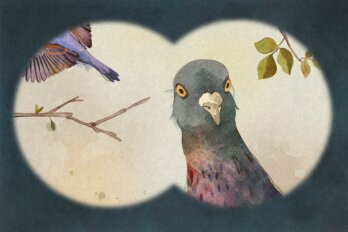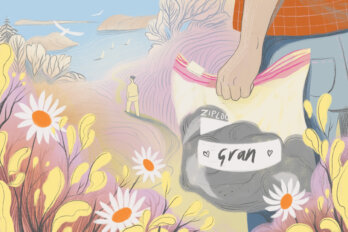If one were to engineer the optimal activity to help us not only navigate but even enjoy the coldest, darkest months, it would need to satisfy certain criteria. To be safe amid the COVID-19 pandemic, it should be outdoors, regardless of snow or sleet. It should provide a boost for our bodies and brains, to keep the human machine functioning smoothly during a season when it may be repeatedly tested. It should be social as long as it’s safe, but it could also be solo, for those times when we just need some space. Staying local, to reduce viral transmission, would be good. So would something accessible to as many people as possible, notwithstanding hurdles of age, affluence, and ability—differences that determine what we can do, and where and when we can do it, to take care of ourselves. And, considering that climate change was a big concern before COVID-19 changed the channel, it would be nice to tread lightly on the planet while trying to stay sane and in shape.
As we take tentative, hopeful steps into 2021, can any single activity accomplish all this? There may be no magic-bullet cure for the collective but inequitable challenges we currently face—challenges amplified by the one-two punch of a deadly virus reaching new heights and a Canadian winter. In the summer, we sought solace by picnicking in parks, debriefing on driveways, and commiserating in canoes. We watched the sun set while wearing T-shirts and sitting on the curb at least two metres apart from our neighbours. But, with the temperatures below zero and snow falling, now what? Now: walk.
It’s easy to overlook this ancient way of getting around. Even though my book, Born to Walk, about the transformative properties of walking, was published just six years ago, I’m guilty of bipedal amnesia myself. For months, since the first round of lockdowns began last March, I self-medicated by going on long runs and doing online boot camp classes in my basement. Exercise helped me tamp down anxiety, expending energy that might otherwise have wandered toward boredom and worry. By December, however, all that pounding took its recurring toll on my middle-aged knees and back, and the ice packs, painkillers, and physiotherapy that followed were draining. Plus, unlike in March, when the prospect of milder weather was around the corner, there were no lazy, hazy days on the horizon. So, in the midst of near minus-twenty stretches of cold, the early-winter sun slanting low over my hilltop neighbourhood in semi-suburban Ottawa, my mood succumbing to a similar trajectory, I put on my boots and went outside.
A few blocks from my house, a single-track desire line—an unofficial path carved out by foot traffic—leads into the trees off a busy arterial road. The trail follows the ridge of a ravine, the frozen curves of a creek visible at the bottom of a leafless slope. I carefully descend a spur to the waterway’s edge and engage in some low-impact trundling, tossing rocks and sticks into the air to see if they’ll crack the ice when they land. They skitter and whirr across the solid surface, high-pitched reverberations echoing off the valley walls. Right before the path climbs to a quiet residential road, atop a promontory bound on three sides by a C-shaped meander, I spot a tidy guerilla campsite: tent, tarp, hibachi. It looks like a postcard and delivers a jolt of perspective. Walking in our own neighbourhoods connects us to the human and natural ecosystems where we are right now, deepening our relationships with the tangible world in ways that Zoom cannot. Exposure to these realities helps shape how we interact with the people and places in our communities and can encourage socially and environmentally constructive behaviour. As I exit the ravine, above my head, the city’s crow commute, a daily dusk-hour journey to the birds’ east-end roost, traces a scraggly black arc across the sky.
Nothing extraordinary happened that afternoon. My not-yet-acclimated face was stung red by the wind. My fingers got cold. I forgot to bring my handkerchief (an essential piece of technology on a winter walk) but did remember to stop for milk and bananas on the way home. It was simply a short respite from video meetings, pandemic news coverage, and a boisterous bungalow with our two teenage daughters home from school. Yet my knees and back loosened up and the churn in my brain settled. I felt gratitude, energy, optimism—“a state in which the mind, the body and the world are aligned, as though they were three characters finally in conversation together,” Rebecca Solnit writes in Wanderlust, “three notes suddenly making a chord.”
As long as you have the right gear—for me: insulated footwear, layers, a toque, and mitts—and the corporeal capacity, walking is an ideal way to stay comfortable while outdoors in winter. Even at a moderate pace, our muscles need oxygen to contract, which makes us breathe faster, sending oxygen-rich blood throughout our bodies and keeping us warm; bring enough water and snacks and the movement is eminently sustainable. This sheds a few calories, of course, and there are myriad more physiological rewards, from building bone mass and enhancing balance to protecting us from heart attacks and strokes. Walking is the single most practical thing we can do for our health, family medicine professor Mike Evans told me when I was doing research for my book. When gyms and pools are closed, and when running and cycling atop icy ground is tricky, that makes walking pretty much indispensable. But it’s the impact of walking on our psyches—and on our encounters with others—that may provide a more crucial lifeline in these grey, lonesome weeks of winter.
The positivity we feel during or after a walk, no matter the weather, isn’t happenstance. Rather, it’s the result of how our brains respond to natural environments, including tiny pockets of urban green space, and how we process information accumulated at a pedestrian four to six kilometres per hour. When I was in that ravine, the sunlight filtering through the barren trees, the rocks whirring across the ice and the crows flying overhead held my focus in an effortless way. This “soft fascination,” a term coined by American environmental psychologists Rachel and Stephen Kaplan, bestows a sense of serenity, and at the same time, it frees your mind to reflect on your surroundings and explore other thoughts. The Kaplans’ attention restoration theory, which emerged in the 1980s, holds that this type of relaxation allows us to clear up “cognitive residue,” the detritus that builds up in a brain that’s bombarded with bits and bytes all day. Moreover, when you’re on foot, moving at the speed our ancestors evolved to travel at, you’re taking in new stimuli at a rate we’re hardwired to absorb (compared to observations gleaned from the window of a speeding car—or on the internet). This stream of sights and sounds and smells commingles with all of the ideas already bouncing around inside your head, sparking creative thinking and allowing you to imagine possibilities—say, a world where everybody has been vaccinated against COVID-19—that don’t yet exist.
Although the restorative properties of walking in a natural area are more pronounced than in an urban environment—where traffic noise, for instance, can keep our fight-or-flight response on alert—we also earn psychological dividends by exploring or travelling through cities and towns on foot. Since many of us walk, out of necessity or choice, along gritty streets and alleys, this is hugely significant. Streetscapes that are safe and interesting, argues American city planner Jeff Speck in his book Walkable City, give us reaffirming glimpses of human vitality. Despite lockdowns and curfews and other restrictions, the so-called “weak tie” casual exchanges that we have while out on foot (a smile from a neighbour, a brief chat with a barista or bus driver) contribute to our feelings of belonging and happiness by reminding us that we not alone. Urban walking opens the door to serendipitous experiences not curated by algorithms, to sinking into the rhythms of the complex communities where we call home. As planning consultant Jane Farrow and University of Toronto geography professor Paul Hess wrote in a report about walkability in their city, “Walking environments are not simply routes from A to B. They are connective tissue where critical social interactions can occur that knit people together.”
Not everybody can explore off road or atop obstacles, so access to sidewalks cleared of snow and ice or roadsides where one is safe from vehicles and other threats should be a basic right in Canada. In many cities, we appear to prioritize the maintenance of routes for cars and trucks during and after storms. Access for ambulances and firefighters is one of the reasons, but there’s also an economic motive: people driving to work, goods getting to shops. This doesn’t have to be the case (especially right now). In Stockholm and other Swedish cities, the municipality first clears snow from sidewalks, bike paths, bus lanes, and walkways that lead to daycare facilities and schools. This winter, maintenance crews in Toronto began plowing snow on a couple hundred kilometres of sidewalks in the urban core that the city had previously left for residents to deal with, as well as cleaning additional kilometres for walkers in parks. A preview, possibly, of more widespread changes to come.
Because many Canadians are either home alone or hibernating with their families this winter, working and studying in makeshift offices and classrooms, we’re more isolated than ever. Creating more space for walking will help us exercise and socialize safely, as long we remain sufficiently far apart and wear masks. And, when you go for a walk with company, you’re not only deriving all of the aforementioned benefits, you also tend to engage in conversation without making eye contact—a relationship to your companion that, as author Michael Pollan references in his book Cooked, can spark openness and honesty. Travelling in tandem, your footfalls can settle into an unconscious symmetry—even if you’re six feet from each other—which, according to a paper written by a pair of Dutch psychologists, can be a sign of “shared feelings of rapport . . . of mutual attention and positivity.” What’s more, as slow-living expert Carl Honoré told me when I interviewed him for my book, “Away from clocks and technology and the distractions of the modern world, walking creates a vast open space for things to happen, and that’s often when relationships flower and blossom most.”
My wife, Lisa, and I experience this during after-dinner walks near our house with our daughters. On subzero evenings when the girls were unable to sit around outside with their friends and were tired of screens, they were so bored that they began joining us on these digestif outings, a habit they (and we) had dropped years earlier. Now, however, they share aloud the minutia of their days, offloading the weight of their worries. They also compete to spot the first cat skulking in the shadows, critique the sea of lingering holiday light displays, and sometimes, march ahead arm-in-arm, giggling and deepening a bond that we feared would descend into housebound squabbles.
Winter walks near our house also mean bumping into and catching up with neighbours, or brief yet brightening greetings with dog walkers and other passersby. One night, we noticed five women walking in a perfect V formation, even rounding corners—a socially distant outing for a group of young moms. The next night, we spotted five men approaching in a spaced out one-two-two alignment with drinks in hand. The husbands. “It’s our sip and stride,” one confided as they passed. Cutting through the greenbelt that abuts our local park, we followed a mysterious set of footsteps in the snow to a path snaking through thick forest—a trail we had never seen in a dozen years living right around the corner, a metaphor, perhaps, for the discoveries that await when we slow down and open our eyes.




